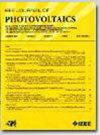设计提高非晶态硅基砷化镓顶层电池的缺陷容忍度
IF 2.6
3区 工程技术
Q3 ENERGY & FUELS
引用次数: 0
摘要
迄今为止,单片 III-V/Si 串联(多接面)太阳能电池(如 GaAs$_{0.75}$P$_{0.25}$/Si)的最大性能限制是晶格失配异质外延造成的过量穿线位错密度 (TDD)。最近在低 TDD GaAsyP1-y/Si 变质缓冲器方面取得的进展被用于在硅上生长独立的 GaAs$_{0.75}$P$_{0.25}$ 顶层电池,其 TDD 为 4 × 106 cm-2,比以前的迭代低 2.5 倍,从而大大提高了在此平台上生产高效串联电池的潜力。尽管如此,这些缩小的 TDD 电池仍然存在相当大的电压相关载流子收集(VDC)损耗。因此,为了在不降低 VOC 的情况下提高 JSC 和填充因子,设计并实施了电池基底层内的掺杂梯度。更新后的设计将 VDC 损耗降低到了在典型的平掺杂剖面设计中需要进一步将 TDD 降低至少 2.5 倍(至 ≤ 1.5 × 106 cm-2)的水平。用 p+Al$_{0.2}$Ga$_{0.8}$As$_{0.74}$P$_{0.26}$ 取代 p+-Ga$_{0.64}$In$_{0.36}$P 背表面场,在 VOC 和 JSC 方面都有了额外的改进,器件性能相当于先前设计的 TDD 降低了 4 倍。这些设计变更的最终结果是,新子电池的 AM1.5G 绝对效率比以前的最佳顶级电池高出 4.3%,填充因子、JSC 和 WOC 的绝对值分别提高了约 3.3%、1.9 mA/cm2 和 0.12 V。这一新设计与缩小的 TDD 平台相结合,为在器件完全集成后开发更高效率的 GaAs$_{0.75}$P$_{0.25}$/Si tandems 铺平了道路。本文章由计算机程序翻译,如有差异,请以英文原文为准。
Design for Increased Defect Tolerance in Metamorphic GaAsP-on-Si Top Cells
To date, the greatest performance limiter in monolithic III-V/Si tandem (multijunction) solar cells, like GaAs
$_{0.75}$ $_{0.25}$ y
P
1-
y
/Si metamorphic buffers were used to grow standalone GaAs
$_{0.75}$ $_{0.25}$ J
SC
and fill factor, without sacrificial reduction in
V
OC
, a doping gradient within the cell base layer was designed and implemented. The updated design reduces VDC losses to levels that would otherwise require further TDD reduction by at least another 2.5 × (to ≤ 1.5 × 10
6
cm
−2
) in a typical flat doping profile design. Replacing the p
+
-Ga
$_{0.64}$ $_{0.36}$ $_{0.2}$ $_{0.8}$ $_{0.74}$ $_{0.26}$ V
OC
and
J
SC
, yielding device performance equivalent to a 4 × TDD reduction in the previous design. The culmination of these design changes results in a new subcell that outperforms our previous best top cell by ∼4.3% absolute AM1.5G efficiency, with increases in fill factor,
J
SC
, and
W
OC
of about 3.3% absolute, 1.9 mA/cm
2
, and 0.12 V, respectively. This new design, coupled with the reduced TDD platform, paves a promising path toward the development of higher efficiency GaAs
$_{0.75}$ $_{0.25}$
求助全文
通过发布文献求助,成功后即可免费获取论文全文。
去求助
来源期刊

IEEE Journal of Photovoltaics
ENERGY & FUELS-MATERIALS SCIENCE, MULTIDISCIPLINARY
CiteScore
7.00
自引率
10.00%
发文量
206
期刊介绍:
The IEEE Journal of Photovoltaics is a peer-reviewed, archival publication reporting original and significant research results that advance the field of photovoltaics (PV). The PV field is diverse in its science base ranging from semiconductor and PV device physics to optics and the materials sciences. The journal publishes articles that connect this science base to PV science and technology. The intent is to publish original research results that are of primary interest to the photovoltaic specialist. The scope of the IEEE J. Photovoltaics incorporates: fundamentals and new concepts of PV conversion, including those based on nanostructured materials, low-dimensional physics, multiple charge generation, up/down converters, thermophotovoltaics, hot-carrier effects, plasmonics, metamorphic materials, luminescent concentrators, and rectennas; Si-based PV, including new cell designs, crystalline and non-crystalline Si, passivation, characterization and Si crystal growth; polycrystalline, amorphous and crystalline thin-film solar cell materials, including PV structures and solar cells based on II-VI, chalcopyrite, Si and other thin film absorbers; III-V PV materials, heterostructures, multijunction devices and concentrator PV; optics for light trapping, reflection control and concentration; organic PV including polymer, hybrid and dye sensitized solar cells; space PV including cell materials and PV devices, defects and reliability, environmental effects and protective materials; PV modeling and characterization methods; and other aspects of PV, including modules, power conditioning, inverters, balance-of-systems components, monitoring, analyses and simulations, and supporting PV module standards and measurements. Tutorial and review papers on these subjects are also published and occasionally special issues are published to treat particular areas in more depth and breadth.
 求助内容:
求助内容: 应助结果提醒方式:
应助结果提醒方式:


